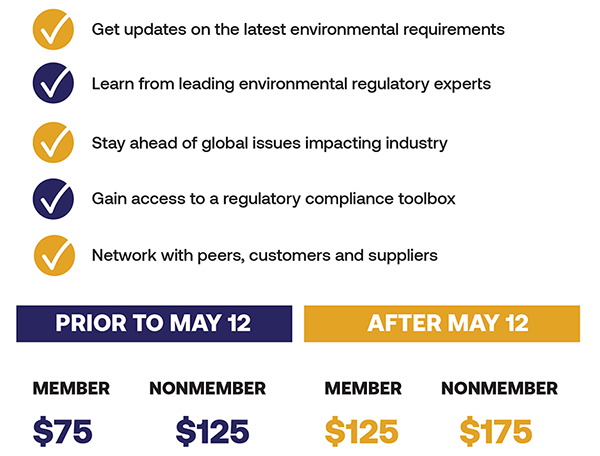AGENDA | REGISTRATION OPTIONS | MEET OUR SPEAKERS | SPONSORSHIPS
Staying informed on chemical, product, and sustainability policies impacting the electronics industry can be a daunting task. After 10 years of partnership, IPC and ITI are joining forces again to keep you ahead of the curve. At the 2023 Virtual Critical Environmental Requirements for Electronics Conference, you will hear from the key government officials and technical experts who are developing and implementing policies governing the electronics industry.
If you play a role in ensuring your organization complies with ever-evolving requirements, this virtual conference will provide the tools you and your organization need to comply with legal and customer requirements. At this conference, you will:
- Learn about sustainability and eco-design policies in the U.S. and EU
- Obtain valuable information on the dynamic landscape of PFAS regulations
- Network with peers, customers, and suppliers in the electronics manufacturing industry
- Gain insights on the EU Restriction of Hazardous Substances in Electrical and Electronic Equipment (RoHS) General Review and changes to exemptions and new substances
- Discover the importance of industry data and participation in studies during regulatory consultation periods
Silver sponsor video
11:00 AM ET Welcome to Conference + Overview of the Event | Chris Cleet, ITI & Suhani Chitalia, IPC
11:15 AM ET Navigating ESG and Responsible Business Conduct Legislation in the EU | Julian Lageard, Director, Global Government Affairs, Intel Corporation
- Description: This session looks at trends in EU legislation on ESG disclosures, reporting and responsible business conduct including mandatory due diligence obligations together with what it means for companies.
11:45 AM ET Q&A with Julian Lageard
12:05 PM ET The PFAS Universal REACH Restriction | Nicolas Robin, Director of Fluoropolymer Products Group, PlasticsEurope
- Description: On 7 February 2023, Netherlands, Denmark, Germany, Norway and Sweden proposed a REACH restriction to “prohibit the manufacture, use or placing on the EU market of PFAS substances on their own or as another constituent in a mixture or article.” The 5 dossier submitters decided to consider PFAS as a single homogenous group. This session will discuss how the proposed restriction will have important and direct implications on your industry.
12:35 PM ET Q&A with Nicolas Robin
12:50 PM ET BREAK
1:05 PM ET Panel with the Strategic Management Team (SMT) of the RoHS Umbrella Industry Project
- Description: The RoHS Umbrella Industry Project is a unique cross-industry initiative, currently involving 73+ industry associations worldwide, fostering dialogue across the sector on the adaptation to scientific and technical progress of existing RoHS Exemptions and global industry alignment on technical substitution possibilities. The chairs of the project will give an overview of the structure and possibilities for participation within it, alongside a discussion on these RoHS specific issues: the latest status of the RoHS 2 Review; the latest news of the Exemption Packs; and the latest developments about additional substances.
Moderator:
- Chris Cleet | ITI
Panelists:
- Steven Andrews | Assent
- Sue Fortunato-Esbach | Assent
- Michael Müller, Ph.D. | Rosenberger GmbH
2:05 PM ET Preparing for the Increasing Chemical Regulatory Restrictions Affecting Semiconductor and Electronics Manufacturing Operations | Kevin Wolfe, Corporate Environmental Engineer, Intel Corporation
- Description: This session intends to provide a recommended pathway to understand and respond to developing regulatory restrictions, with an aim to avoid disruptions to supply chain and manufacturing through proactive actions.
2:35 PM ET Q&A with Kevin Wolfe
2:50 PM ET Circularity in the Biden-Harris Administration: An Overview of U.S. Efforts to Enhance Circularity | Elizabeth Nichols, Ph.D., U.S. Department of State (DOS), Bureau of Oceans and International Environmental and Scientific Affairs (OES), Office of Environmental Quality (ENV)
- Description: The United States Government is expanding its efforts to enhance circularity across multiple sectors and resource value chains through both domestic and international policy engagement. This presentation will offer a snapshot of federal engagement across multiple agencies, as well as an overview of the state of play of international circularity policies.
3:20 PM ET Q&A with Liz Nichols
3:35 PM ET Conclusion
REGISTRATION OPTIONS
This event is under Chatham House Rules. All press inquiries should go to Sandy Gentry.

Chris Cleet - Moderator, Vice President, Policy, Environment and Sustainability, ITI
Chris Cleet provides expertise on technical environmental issues such as materials restrictions and best practices for electronics recycling. He leads the Environmental Leadership Council's Product Stewardship and Green Procurement committees which aim to ensure that environmental standards, and state, federal and international laws are based on sound science.
He is a certified qualified environmental professional (QEP) through the Institute of Professional Environmental Practice (IPEP).

Kevin Wolfe, Corporate Environmental Engineer, Intel Corporation
Kevin Wolfe is an environmental engineer working within the Global Environmental group within Intel Corporation, where he has been working in various EHS capacities for the past 23 years. Recent responsibilities have included providing ownership for wastewater environmental regulatory compliance worldwide, as well as the establishment of environmental risk assessment processes to enable compliance to environmental permitting requirements to semiconductor fab and assembly/test manufacturing facilities upon transfer of new manufacturing process technologies. Current responsibilities include coordination of all preparatory activities for emerging PFAS restrictions and regulations within Intel, as well as driving similar activities within semiconductor manufacturing industry associations.

Elizabeth Nichols, Ph.D., U.S. Department of State, Bureau of Oceans and International Environmental and Scientific Affairs, Office of Environmental Quality
Liz Nichols leads on circular economy for the U.S. Department of State and is a member of the U.S. delegation to the Intergovernmental Negotiating Committee (INC) to develop an international legally binding instrument on plastic pollution, where she leads for the United States on finance. She has deep expertise in developing and negotiating innovative international environmental policy and multilateral financing solutions, developing strategic partnerships, and bridging the science-policy-practice interface. Prior to joining the State Department, Liz was a university professor, with a research focus on biodiversity science and quantitative policy analysis and earned her Ph.D. from Columbia University. She fell in love with the West Coast during the pandemic and currently remotely works from Eugene, Oregon.

Suhani Chitalia - Moderator, Environmental Regulatory Affairs Manager, IPC
As IPC’s environmental regulatory affairs manager, Chitalia is responsible for monitoring global environmental policy developments and regulatory requirements, liaising with industry members and policymakers, and developing responses to consultations, questionnaires, and calls for evidence from government entities.
Licensed to practice law in the state of Maryland, Chitalia served as an environmental law staff attorney at the University of Maryland School Francis King Carey School of Law and most recently as a government relations associate at lobbying firm, Public Policy Partners. She has extensive experience lobbying for climate change and environmental health legislation, and advocating for environmental justice concerns and public health in Maryland.

Nicolas Robin, Director of Fluoropolymer Products Group, PlasticsEurope
For more than 25 years, Nicolas has been involved in French and European politics – both as an actor, and also as an observer of the often complicated and Byzantine world of how Brussels functions. He has a track record of successfully shaping public policy at the EU and national levels on energy, the environment and reputation issues. Prior to his role in PlasticsEurope, Nicolas worked as in-house PA director for a leading glass packaging company, general secretary for electronic and payment system trade associations and manager of Brussels based PA consulting firms.

Sue Fortunato-Esbach, Regulatory & Sustainability Expert, Product Sustainability, Assent
Sue is a Regulatory and Sustainability Expert at Assent with a focus on European law. She has an academic background in environmental sciences and law. Before joining Assent, Sue headed the product compliance team at a German manufacturer of electrical and electronic equipment and machinery. In this role she accompanied the product development to ensure that the products complied with EU and US law. Sue is active in trade associations on European level in order to share knowledge and stay abreast of regulatory developments in Brussels. She is passionate about helping companies make sense of the regulatory maze and uses her industry experience and regulatory expertise to advise and guide Assent clients.

Julian Lageard, Director, Global Government Affairs, Intel Corporation
Julian was born in England in 1968, holds a Bachelor of Arts Degree from Lancaster University and a Master of Science Degree from Imperial College, University of London. He worked in the European Parliament from 1992-94 and subsequently as a consultant in EU affairs. Since 2000, Julian has been based in the Brussels office of Intel Corporation and is Director, Global Government Affairs. He has worldwide responsibility for ESG and Responsible Business Conduct policy. Julian chairs AmCham EU’s Task Force on Responsible Business Conduct as well as the DigitalEurope and techUK groups on Responsible Business Conduct. He is a member and one of the founding strategic partners of the European Partnership for Responsible Minerals (EPRM), Member of the OECD Multi-Stakeholder Group (MSG) on Responsible Minerals Supply Chain and Member of the Business at OECD Committee on Investment and Responsible Business Conduct.

Steven Andrews, Regulatory & Sustainability Expert, Product Sustainability, Assent Inc.
Steven Andrews works with companies to help them understand environmental product regulations and how they are enforced. He is an internationally recognized expert, with more than 20 years of experience in European Union (EU) policy development focusing on sustainability, product, waste and recycling legislation.
As the former Deputy Head of the Resources & Waste Division at the UK government’s Department for Environment, Food & Rural Affairs, he led teams responsible for developing and enforcing policy around the EU’s RoHS, Batteries, and Waste Electrical and Electronic Equipment (WEEE) Directives, as well as broader legislation with an environmental and sustainability focus.

Dr. Michael Müller, Manager Product Compliance, Rosenberger GmbH
Michael Müller, Ph.D., heads the product compliance team at Rosenberger Hochfrequenztechnik GmbH & Co. KG. He has an academic background in organic chemistry. He is active in the implementation of product compliance laws since more than ten years. Michael is active in standardization and trade associations to understand best practices and transport them into standards as well as to support the law giver during intended involvement of stakeholders. Since 2021 Michael has served as chair of the Umbrella Project and since 2016, has served as co-chair of the working group for exemption 6(c) in the Umbrella Project.
Cost is $3,000 – Limit four (4)
- A 4-minute time slot for a pre-recorded or live sponsor presentation during the event on June 6, 2023. Pre-recorded messages will also be shared on the event website. *Subject to approval by ITI and IPC.
- Your logo prominently displayed on the conference website, event promotional materials, and event kick-off slides. Your digital logo can be hyperlinked to your company website or sponsorship content of your choice.
- Acknowledgement in 1 event social media post promoting the event.
- Two registrations to the virtual conference.
- Pre-event registration contact list for all consenting attendees prior to the event.
- Access to event proceedings (pdf of slide presentations as permitted by speakers).
- Final registration contact list for all consenting attendees no more than 2 weeks post event.
- Sponsors acknowledged on any post-event communications sent by ITI-IPC to registered attendees.
Cost is $1,500 – Limit ten (10)
- A 1-minute time slot for a pre-recorded presentation during the virtual presentation on June 6, 2023. Pre-recorded sponsor presentation during the virtual event on June 6, 2023. Pre-recorded messages will also be shared on the event website. *Subject to approval by ITI & IPC.
- Your logo prominently displayed on the conference website, event promotional materials, and event kick-off slides. Your digital logo can be hyperlinked to your company website or sponsorship content of your choice.
- Acknowledgement in 1 event social media post promoting the event.
- Mention once during live event.
- One registration to the virtual conference.
- Access to event proceedings (pdf of slide presentationss as permitted by speakers.
- Final registration contact list for all consenting attendees no more than 2 weeks post event.
- Sponsors acknowledged on any post-event communications sent by ITI-IPC to registered attendees.
Cost is $750
- Your logo prominently displayed on the conference website, event promotional materials, and event kick-off slides. Your digital logo can be hyperlinked to your company website or sponsorship content of your choice.
- Mention once during live event.
- One registration to the virtual conference.
- Access to event proceedings (pdf of slide presentations, as permitted by speakers.
- Final registration contact list for all consenting attendees no more than 2 weeks post event.
- Sponsors acknowledged on any post-event communications sent by ITI-IPC to registered attendees.
Our sponsorship sales representative for the 2023 event is Mike Stone. Please contact Mike at MikeStone@ipc.org or +1 847 597-2866 if you need additional information. Sponsorship opportunities will be available on a first come-first serve basis, so please reserve your place today.
THANK YOU SPONSORS
Cancellation Policy:
If you are unable to attend the conference, you may send a coworker in your place. Please notify us of name changes as soon as possible. Registrants who cancel by May 30, 2023, will be refunded in full, but those who cancel after that deadline will be responsible for the full registration fee. Sponsors who cancel by May 30, 2023 will incur a $100 cancellation fee and no refund will be issued for sponsors that cancel after the deadline. If you need to change your registration or cancel, please email Kim DiCianni at KimDiCianni@ipc.org.






